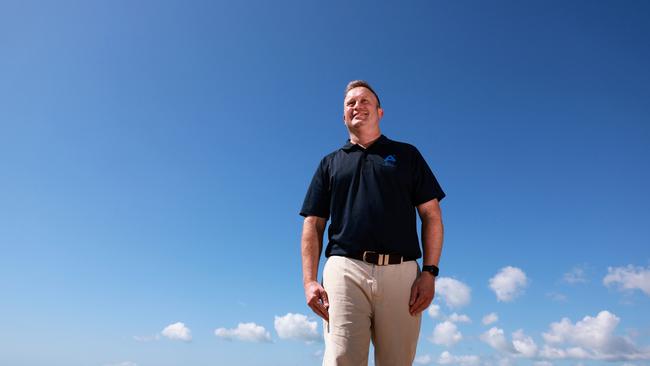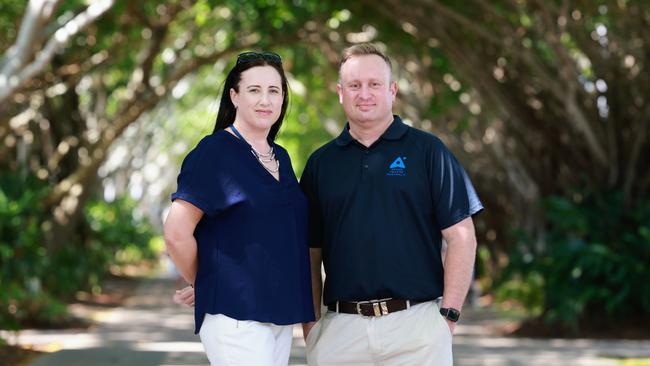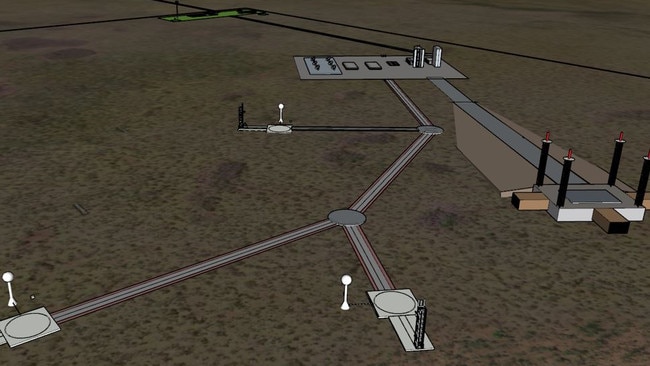Space Centre Australia: CEO James Palmer says station in Cape could fire rockets within five years
Spacecraft and satellites could be sent into space from a permanent Far North launch site within five years, bringing more than 300 jobs and a virgin industry to the region.
Cairns
Don't miss out on the headlines from Cairns. Followed categories will be added to My News.
The Far North could have rocket ships whizzing overhead, carrying satellites into the thermosphere, within five years.
Space Centre Australia’s (SCA) planned spaceport near Weipa has already progressed into unprecedented territory with a selected site, a funding pipeline negotiated and environmental assessments started alongside an Indigenous Land Use Agreement with the local traditional owner group, the Mokwiri Aboriginal Corporation.
According to project leaders and Brinsmead couple Jane and James Palmer, the entire enterprise will generate hundreds of jobs, many to be recruited from the local region, and will aid prosperity of the Far North’s economy by turning the nascent idea of an Australian space industry into concrete realty.

“This is going to be something for the Far North – a project with immense local ownership,” Mr Palmer said.
“What this latest development means for the project is we can start moving out of the feasibility and concept world and into a development and delivery space.
“We’ll create 300 permanent, full-time jobs at the facility. Our commitment is to get as many local people in those roles as we can.
“The Far North is primed for a new industry and we’ve got the enablement to bring that industry here. I’m the owner and director, and I’m a local, and I want to see the proceeds of SCA go back into the community.”
Mr Palmer said he was in negotiations with the Australian Defence Force to secure use of Cape York’s RAAF Base Scherger as an airport for logistics supply, as well as Rio Tinto to repurpose equipment from its Weipa operations for use at the SCA site.
He said launch of a medium payload spacecraft could happen as soon as 2026, with the launch centre to scale from there.
“We’re looking at jumping into construction late 2023 or early 2024, depending where the environmental approvals are at,” he said.

“The ultimate goal is medium-scale launch, payloads up to 2.5 tonnes, from the end of 2026.
“There’s a lot of development work to undertake after that to take us through to 2030 when we can start seeing really big launches occurring.”
Mr Palmer said modern geopolitical circumstances, such as Russia’s invasion of Ukraine, has complicated access to launch sites around the world. This, coupled with immense demand for launch sites in the USA, has rocket owners looking for feasible and dependable launch sites elsewhere.
“At the moment, globally, supply of launch facilities is outstripped by the demand by a factor of three to one,” he said.
“The ability to get yourself into a launch window in any of the facilities in the US is exceptionally difficult and expensive.
“This inclusive model we’ve developed allows both government and industry to use SCA. We’re close to the equator with clear flight paths and trajectories to work with; we’re in a prime position to develop this site as a long-term tenancy option for rocket owners, such as SpaceX.”

Mr Palmer said the project’s financial underpinnings were solid, and a broad range of skill sets were needed.
He said SCA had been working with the Northern Australian Infrastructure Facility for 12 months, which included funding discussions, and the public could expect further funding announcements early next year.
“We’ve set all this up financially to ensure we have enough safeguard as possible. We’ve come out of Covid with a massive recruitment campaign and opening new offices.
“This isn’t just about turning people into those who wear white lab coats. We need people from diverse backgrounds, such as: environmental management; cultural and heritage management; transportation and logistics; security; and, civil, geotechnical and mechanical engineering. Those skills are around here.”
Despite the project’s progress, Mr Palmer, who has worked at space launch sites around the world, tempered expectation with prudence and caution.
“In space work there’s no prizes for second place. If you mess something up, it’s gone for good,” he said.
“When something goes wrong in space, you can usually always trace it back to something that happened where it launched from. It’s very important that we’re developing the right skill sets and people … it’s got to be done right from the beginning. We can’t cut corners or rush this.
“The Space Industry is very immature in Australia – it’s got a long way to go. There’s a lot of work we have to do, and we’re quite committed to doing this right.”
Leichhardt MP Warren Entsch said the SCA project was a “win-win situation” for all stakeholders involved and he had no reason to believe the project wouldn’t come to fruition.
“It’s going to create a great industry. It’s a huge project and they’ve made great inroads. The demand for small satellites is going to grow exponentially over the next few decades,” he said.
“From the traditional owners’ perspective, what a great way to lease out a bit of land to create a long-term economic opportunity. There will be plenty of opportunities to employ people of that area, if they want to take it.”
More Coverage
Originally published as Space Centre Australia: CEO James Palmer says station in Cape could fire rockets within five years




